Expressions of love and romance have inspired artists and poets for centuries to the delight of art enthusiasts. A popular image pursued by artists is the kiss between two lovers. Such an image evokes a treasure trove of symbolic messages of love, life, intimacy, and eroticism. As you might expect there are fascinating facts associated with the most widely recognized works of art and the artists who created them. The kiss in art tells not only the tales of love but also reveals a lot about the artist’s life and source of inspiration.
This art presentation shares examples of the kiss in art by some major artists and includes quotes about love by famous artists.
Banner image: Cropped image of The Kiss, sculpture by Constantin Brancusi
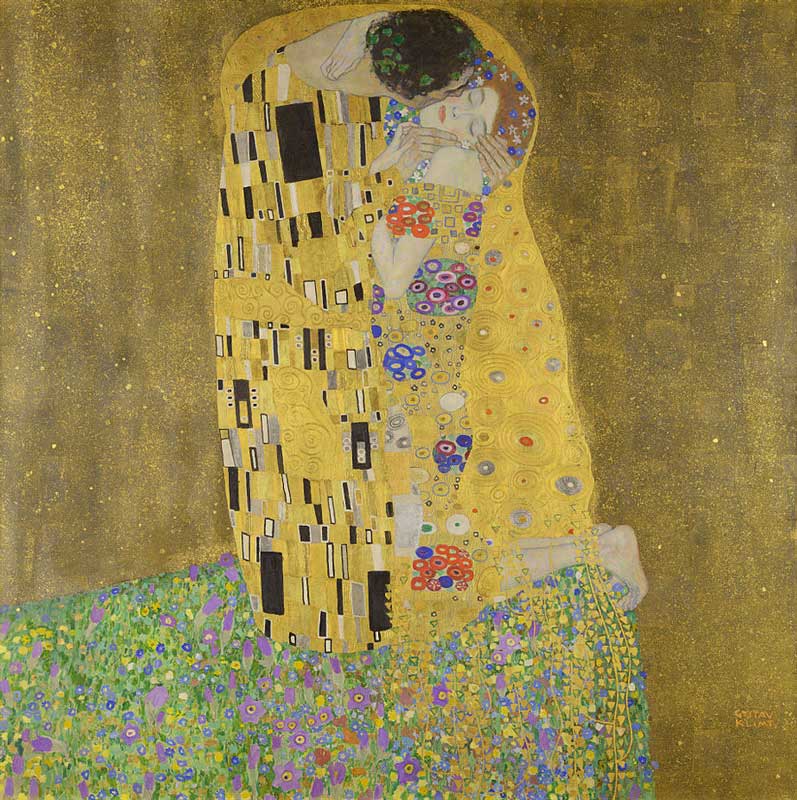 Gustav Klimt, The Kiss, 1907–08, oil on canvas, 70-7/8″ x 70-7/8″. Österreichische Galerie Belvedere, Vienna. Photo: Google Art Project, Public Domain.
Gustav Klimt, The Kiss, 1907–08, oil on canvas, 70-7/8″ x 70-7/8″. Österreichische Galerie Belvedere, Vienna. Photo: Google Art Project, Public Domain.
“The Kiss” by Gustav Klimt, (1862 – 1918) is an example of the artist’s foray into his Golden Period. The pose of the lovers depicted in this painting also reflects the merging of different artistic styles in which Klimt excelled. The natural forms, true to the Vienna Art Nouveau movement, are fused with the bold patterns in the couple’s cloaks, attributed to the impact of the Arts and Crafts movement, while the use of spirals suggests art of the Bronze Age.
One theory is that Klimt and his companion Emilie Flöge modeled for the work. Others suggest the female was the model known as ‘Red Hilda’ because she bears a strong resemblance to the model in his other paintings.
The Belvedere Museum (a.k.a. The Österreichische Galerie Belvedere) paid 25,000 crowns (or about $240,000 today) for this painting when it went on view for the first time.
Read Gustav Klimt: His Art and Life.
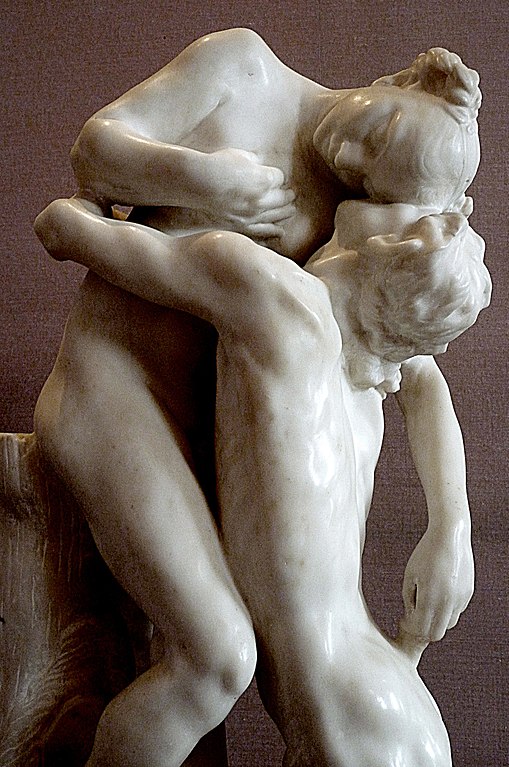
Camille Claudel, Sakountala, sculpture (marble), 1905, Musée Rodin, Paris. Photo: Public domain.
Camille Claudel (1864 – 1943) was a brilliant French sculptor born in Northern France, the child of farmers and gentry. Her mother detested her for not being born a male, and never agreed with her involvement in the arts. She studied at the Academie Colarossi, one of the very few places open to women.
Claudel was also the lover and co-worker of sculptor Auguste Rodin. She created the exquisite sculpture “Sakuntala” in 1905. It has been described as expressing her desire to attain her lifelong search of her artistic identity — free from Rodin’s constraints. The work in plaster earned Claudel an honourable mention at the Salon des Artistes Français art exhibition in 1888. A marble version of this work entitled “Vertumnus and Pomona” is housed at the Musée Rodin. Presented at the Salon d’Automne in 1905, the bronze version was renamed “The Abandonment”.
Sakuntala is a poem by the Hindu poet Kalidasa (ca. 4th-5th centuries).
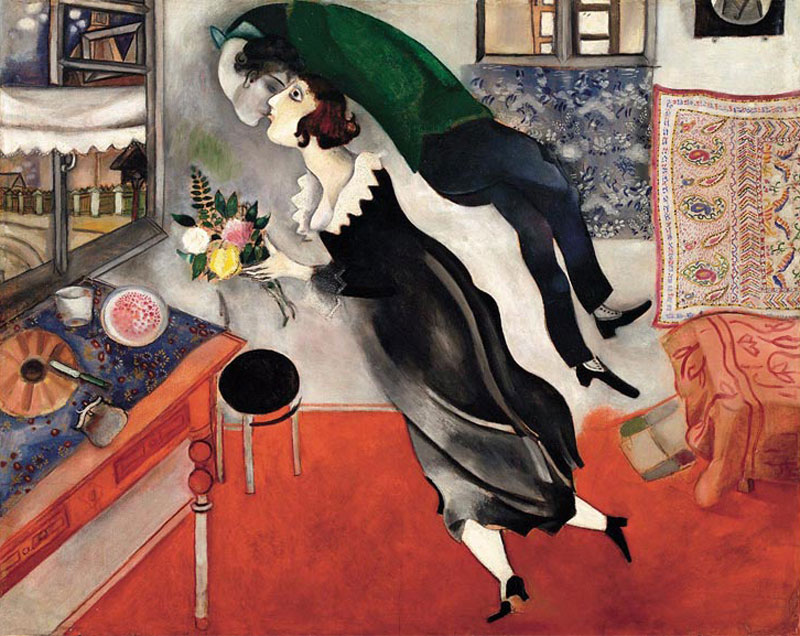
Marc Chagall, L’Anniversaire Huile sur Toile, 32″ x 40″. Photo: Public Domain in the U.S.
Marc Chagall (1887 – 1985), born Moishe Zakharovich Shagal, was a Russian-French artist of Belarusian Jewish origin. He painted “L’anniversaire” upon his return to Russia to propose to Bella. In Chagall’s inimitable poetic style this painting illustrates the power of love and adoration between the man and woman. Suspended in a state of a romantic bliss the two figures float above the physical constraints of reality in a reverie of bliss and peace.
Chagall’s lyrical visual language has placed the artists as one the most important painters of the 20th-century.
“Art must be an expression of love or it is nothing. If I create from the heart, nearly everything works; if from the head, almost nothing.” ~ Marc Chagall
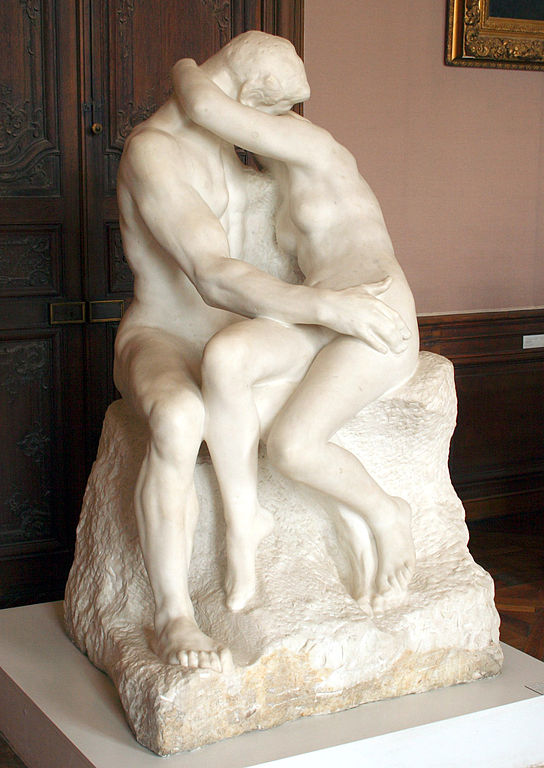
Auguste Rodin, The Kiss, marble, 44.3″ × 46″. The Musée Rodin. Photo: Public Domain.
This article would not be complete without including “The Kiss” by Auguste Rodin, (1840-1917). The sculpture in marble was originally titled “Francesca da Rimini”, as it depicts the 13th-century Italian noblewoman immortalized in “Dante’s Inferno” who falls in love with her husband Giovanni Malatesta’s younger brother Paolo. When critics first saw the sculpture in 1887, they suggested the less specific title “Le Baiser” (The Kiss).
A large numbers of bronze casts have been done of The Kiss. The Musée Rodin reports that the Barbedienne foundry alone produced 319.
“The main thing is to be moved, to love, to hope, to tremble, to live.” ~ Auguste Rodin

Dante Gabriel Rossetti, Paolo and Francesca da Rimini, watercolor, gouache and gum arabic over pencil on paper, one of three parts, created in 1855. In the Tate Britain collection. Photo: Public Domain, Wikimedia.org
Gabriel Charles Dante Rossetti (May 1828 – 1882), known as Dante Gabriel Rossetti, was a British poet, illustrator, painter and translator. His art was characterized by its sensuality and its medieval revivalism. In 1848 he founded the Pre-Raphaelite Brotherhood and was known to have inspired artists and writers influenced by the movement. They aimed at “truth to nature,” which was to be achieved by minuteness of detail and painting from nature outdoors.
His work also influenced the European Symbolists and was a major precursor of the Aesthetic movement. Poetry and image are closely entwined in Rossetti’s work. He remains an important figure in the history of 19th-century English art but his enduring worth probably lies as much in his poetry as in his painting.
 René Magritte, The Lovers, Paris 1928, oil on canvas, 21-3/8″ x 28-7/8″. Photo: Fair Use.
René Magritte, The Lovers, Paris 1928, oil on canvas, 21-3/8″ x 28-7/8″. Photo: Fair Use.
It’s no surprise that the Surrealist artist René Magritte (1898-1967) created a series of paintings in 1928 about lovers from a melodramatic and cinematic perspective. His choice to conceal the subjects identity by covering their faces in cloth is associated with the Surrealist interest in masks, disguises, and the mystery that lies beyond or beneath visible surfaces.
The image may also relate to the graphic illustrations that accompanied pulp fiction and thriller stories.
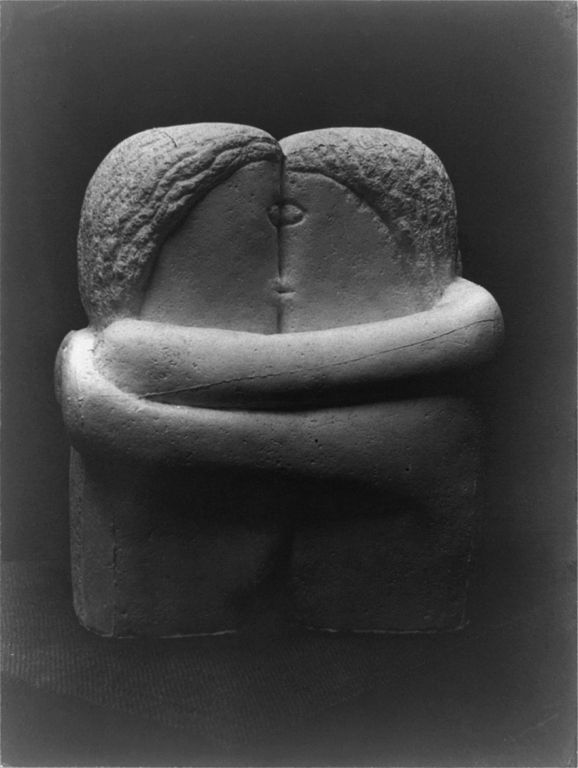
Constantin Brancusi, The Kiss, plaster cast version, 27.9 × 26 × 21.6 cm. Photo: Public Domain on Wikipedia.org
Constantin Brâncuși (1876-1957) created many versions of “The Kiss”. The simplified geometric forms and sparse objects in each version demonstrate his further venturing toward abstraction. Known for his abstract lines and simplified forms he contributed to applying symbolic allusions of representational art. This example shown above in plaster was one of his early renditions on the subject and was exhibited at the 1913 Armory Show and published in the Chicago Tribune, March 25, 1913.
This early plaster sculpture is one of six casts that Brancusi made of the 1907–08. When John Quinn, Brancusi’s patron in New York, saw this piece he commissioned him to create one in limestone.
View Art from Our “Love, Peace, Unity & Hope” Online Exhibition

“It is a matter of loving art, not understanding it.” ~ Fernand Leger
“Poetry and painting are done in the same way you make love; it’s an exchange of blood, a total embrace – without caution, without any thought of protecting yourself.” ~ Joan Miro
“People should fall in love with their eyes closed.” ~ Andy Warhol
“It is good to love many things, for therein lies the true strength, and whosoever loves much performs much, and can accomplish much, and what is done in love is well done.” ~ Vincent van Gogh.
“I am seeking. I am striving. I am in it with all my heart.” ~ Vincent van Gogh
Terrific choices— some of my favorites. Seeing them all together is quite wonderful and makes me appreciate them all the more!
Wendy, Thank you for your feedback. I’m delighted you enjoyed viewing this presentation.
Simply Splendid.
I was searching for images to illustrate the poem “Love and Friendship” by Emily Brontë for my 16-year-old students. I will be using the Rossetti painting after considering several choices. It was wondeful to contemplate your selection. Thank you! Maybe you can put one together about friendship.
Thank you Luz Maria for your comment. I’m delighted to know you enjoyed this presentation. You might also enjoy viewing our online exhibition “Love, Peace, Unity & Hope” with more than 60 works of art by artists from around the world. Here is the link https://manhattanarts.com/love-peace-unity-hope-2025-exhibition-page-1/
I will definitely consider your idea to create a presentation about Friendship!
The love and sincerity are foundation of creation. I love this artists, my favourite between them is Rodin.
Just in time for Valentine’s Day. . .
Loving ALL your articles.
Love never fails. . . Love is All there is. . .
Yes, Irmtraud, I began with the topic of love in art but felt that was too broad. Then the idea of focusing on artwork that portrays affection — as in the kiss — seemed like the way to go. I’m glad you love the article.